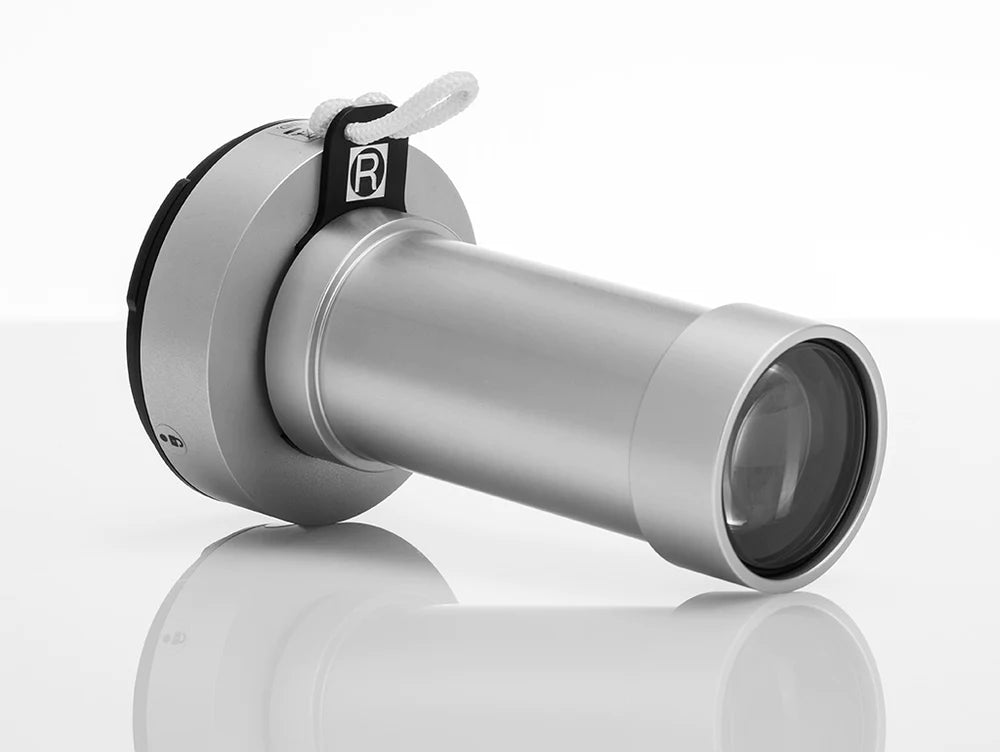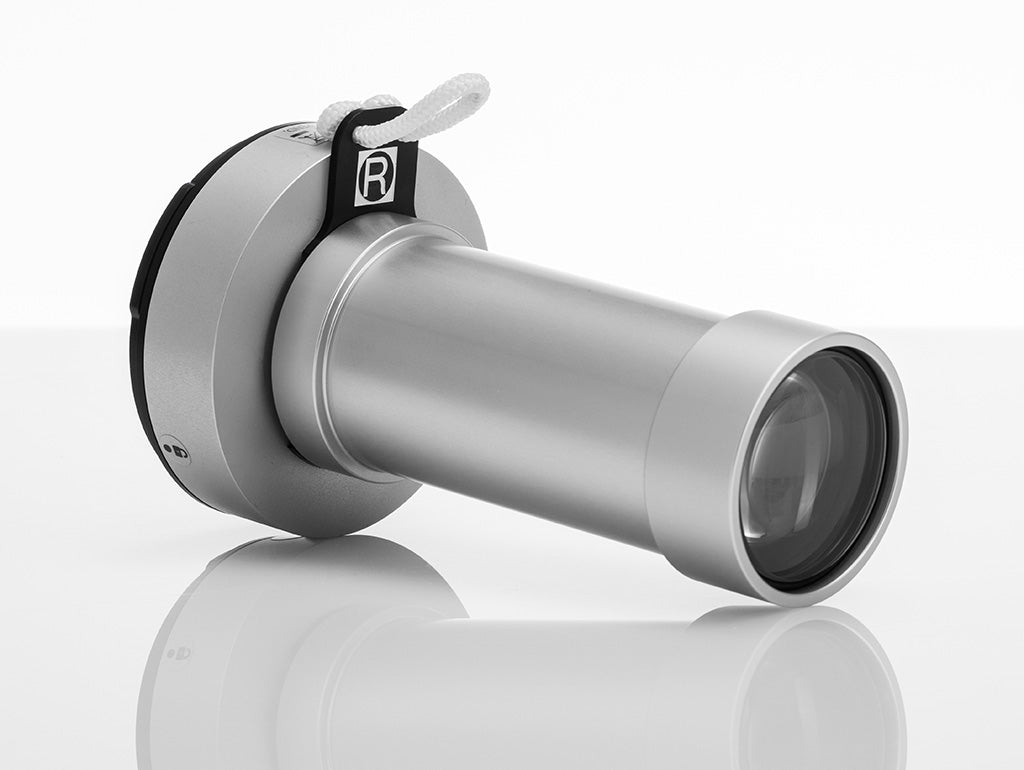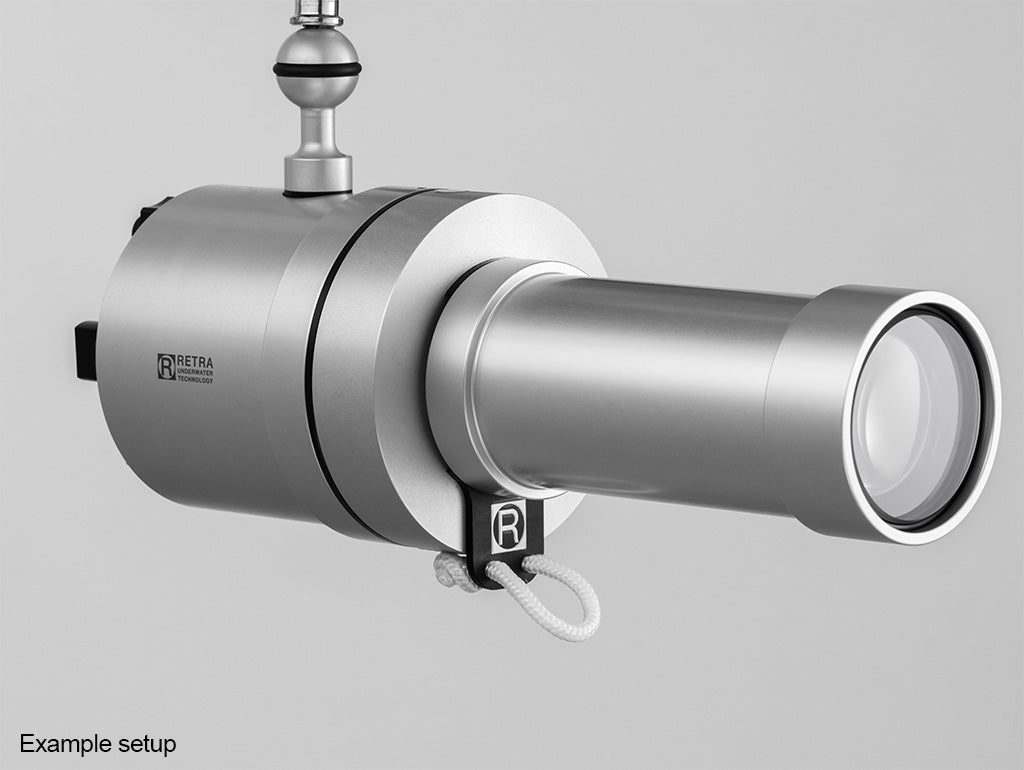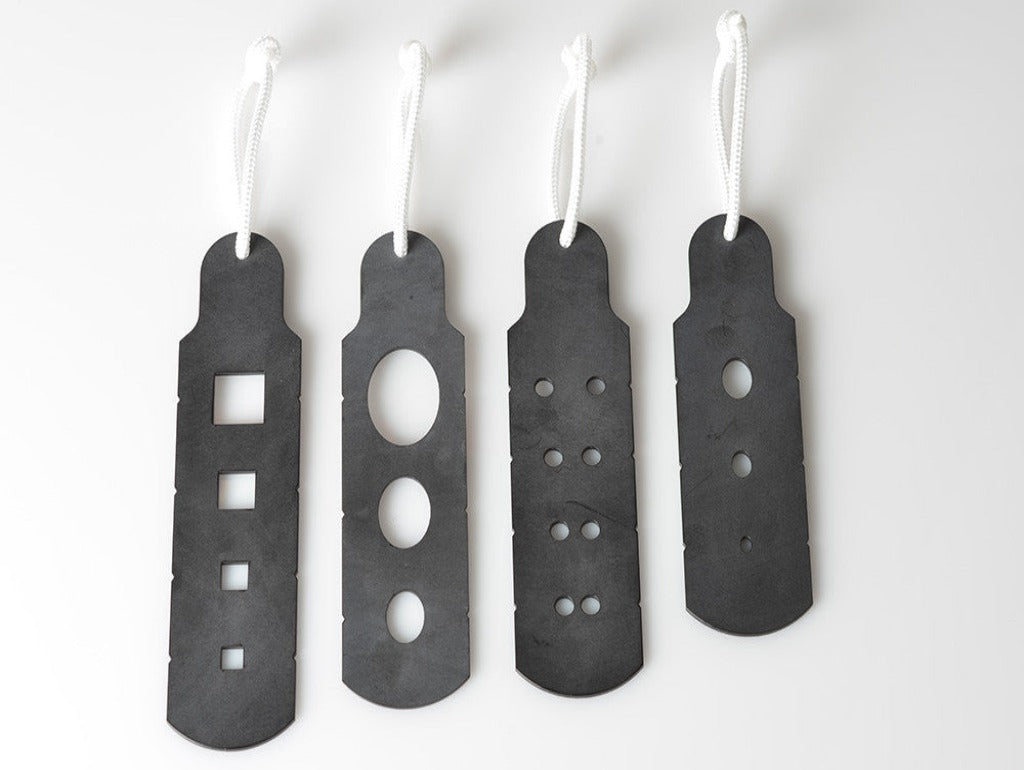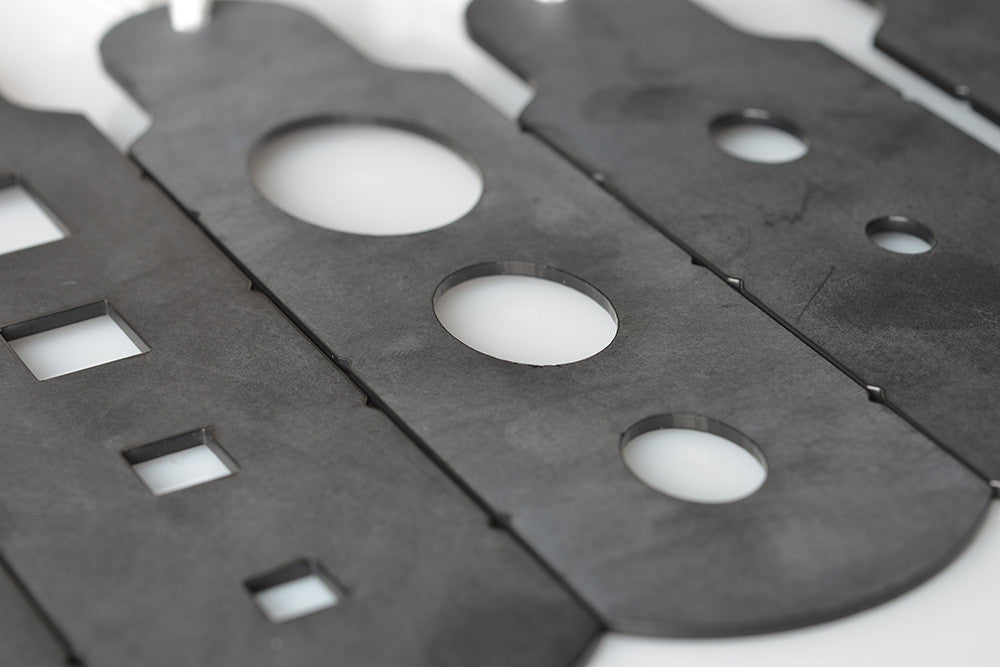INTRODUCTION
Before you skip this article and ignore Retra’s LSD Prime, claiming you’re bored of snoots, it is important to remember that they are photographic tools for far more than just creating spotlights in macro pictures. I’ll get to this below.
This review is focused on Retra’s new, lower cost, LSD Prime (LSD = Light Shaping Device) that went on sale this week (or as Adam cheekily titled the news item “Retra sells Prime LSD”, or something like that). But I’ll also use this article as an opportunity to discuss some of the types of images that snoots can be used for and techniques I use for making these images easily and effectively.
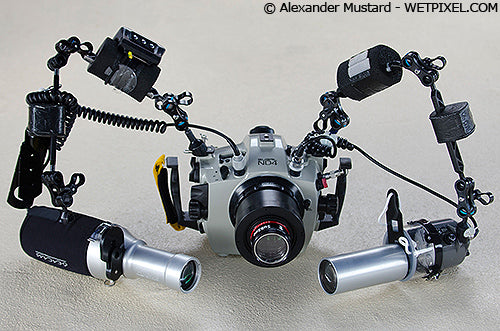
My camera on the Indo Siren in Raja Ampat with an LSD Pro on a Seacam 150 strobe and an LSD Prime on an INON Z240.
RETRA Underwater Technology are a relatively new name in underwater photography, but have already garnered a reputation for producing high quality and original products. With a strong following in the European competition circuit, Retra LSD snoots have been dominating the podiums of Fotosub (on the day style) contests and have already claimed a gold medal for Slovenia in the macro category of the official CMAS World Championship of Underwater Photography in the hands of Rok Kovacic.
As many readers probably don’t know them, I’ll make the introductions. Retra are Oskar Zupancic, Jure Novak and Luka Mali, and while readers from outside of Europe might struggle to pinpoint their Mediterranean country of Slovenia on the map, it is located in a rich belt of European underwater photography bordering both Austria and Italy.
HOW IT WORKS
Few would doubt that the current passion for snoots in underwater photography was inspired by the ground-breaking images of Keri Wilk. I didn’t know Keri five years ago, but I was a judge at several of the major competitions where he swept the board. I remember in one of the Wetpixel/DPG/OWU Contests saying during the judging that I didn’t care which of his snooted shots won the macro category, as long as one of them did, so much did they stand out!
Keri deserves particular praise for going on to share his trade secrets in a now classic reference article on DivePhotoGuide, to which I am proud to have also contributed some images. It was his eye catching photos of macro subjects isolated in spots of light on rich black backgrounds that particular entranced our community.
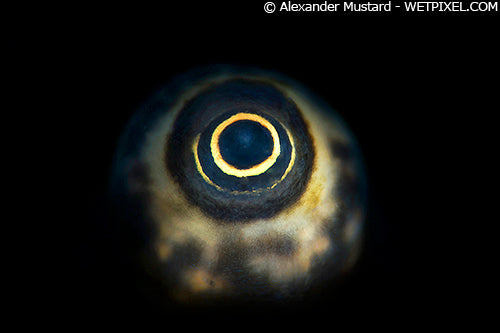
The “macro spotlight” style snoot image, here featuring the eye of a conch in Grand Cayman. While such shots are often the motivation for buying snoots, it is important to remember that snoots can be used for several types of images. Nikon D4, Nikon 105mm VR, Nikon 2x TC AF-S III, Subsee +5. Subal housing. Single INON Z240, Retra LSD Pro with PLE. 1/320th @ f/22. ISO 200.
Keri used a relatively simple tube or funnel type snoot to produce that inspirational portfolio. Those snoots worked by blocking the light from a strobe until only a pinpoint remained. There were two main problems, first the snoot had to be positioned very close to the subject to maintain the small point of light and second being a reductive snoot, most of the power output of the strobe was wasted. As a result many of Keri’s shots were taken at night, to avoid the daylight overpowering the spotlight.
This is where Retra comes in. Their LSD snoots don’t reduce the light from your strobe, but focus its power into a collimated beam, providing both a greater working distance and more power. Allowing us to shoot those rich black backgrounds, even in the middle of the day. Note that for the conch eye, above, I could shoot at f/22 at ISO 200 (and 1/320th) therefore eliminating all daylight easily from my shot, despite being on shallow, white sand under the Caribbean sun.
For a bit more on the theory of Retra’s LSD, I refer you to the Wetpixel review of the LSD Pro by (yet another) Slovenian underwater photographer Borut Furlan, who also helped in the development of the product.
As I said, the LSD Pro has been popular amongst European Fotosub photographers, but the relatively high price (600 Euros, including taxes) has restricted its appeal. This is the motivation for the LSD Prime, which at 349 Euros, including taxes, is aimed at appealing to a mainstream audience. Both versions use the same lens technology, the cost savings come from the cheaper LSD Prime being is a slightly less elegant design, without the very high quality of finish of the Pro. I found the Prime version to be a little less light efficient than the Pro versions too. Nonetheless it is still a quality item and feels close to indestructible. (Since both LSDs use the same lens technology, I have used images from both to illustrate this article).
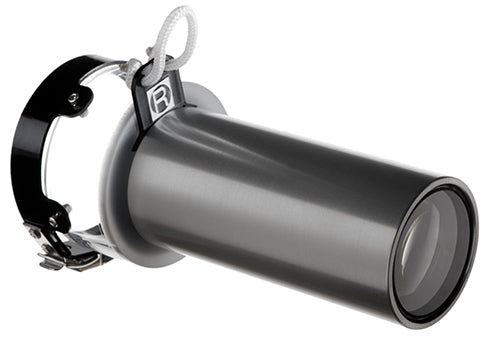
The Retra LSD Prime, note that it has one of the black plastic masks of shapes inserted. The clear chamber does not seem to cause much light loss (presumably because the shiny walls reflect the light back in).
Another major advantage of an optical snoot is that the collimated beam allows you to use different shaped apertures to change the cross sectional shape of the beam. The LSD Prime is supplied with 13 standard shapes for modifying the light beam (the more expensive Pro comes with 8). The most useful are the different sized circular apertures, which simply change the size of the beam. Some of the more obscure shapes are very contrived, but certainly have a role in competition photography, where judges often reward “demonstrable creativity”! It would be relatively straightforward for any user to make their own insert too, and Retra offer to cut additional shapes you might fancy.
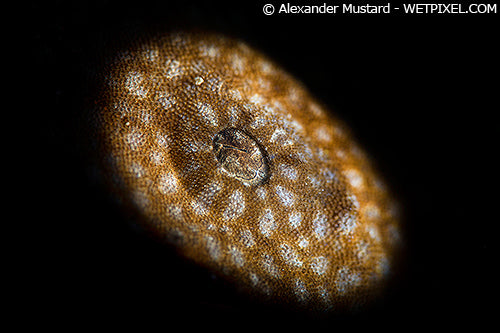
The eye of young woebegone shark in Batanta, Raja Ampat, photographed with the largest circular shaped aperture inserted in the LSD Prime. Nikon D4, Nikon 105mm VR. Subal housing. Single INON Z240, Retra LSD Prime. 1/320th @ f/13. ISO 125.
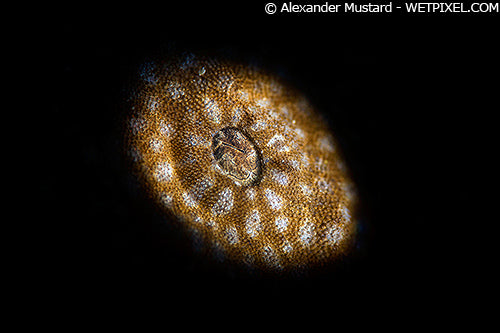
The same scene with the middle sized circular aperture.
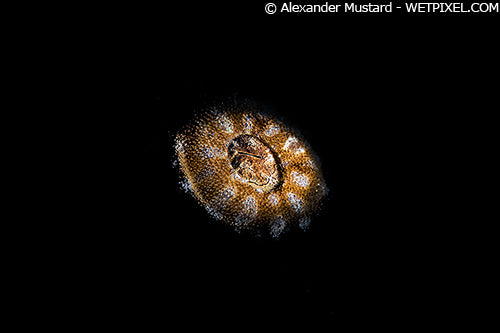
The same scene with the smallest sized circular aperture.
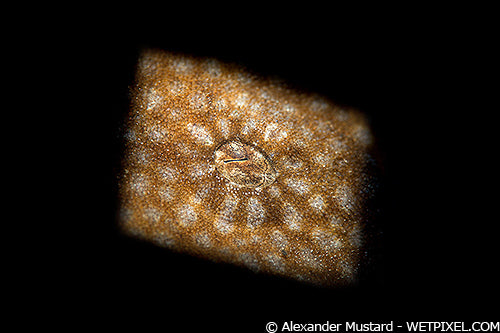
The same scene with a square shaped aperture shaping the LSD beam.
The sharpness of the projected shape is determined by the distance of the LSD from the subject. If the snoot is too close to the subject you will not get even illumination within the beam. Once the working distance is reached, then the shape of the beam will be sharply in focus and evenly illuminated. Further away, and the edges of the shape become less sharply defined, but the illumination remains even: this is defined at the useful range. My shots above were taken with the strobe slightly further away than the working distance (I didn’t want to spook the shark), but well within the useful range, so are not as sharp edged as is possible.
There is a nice, clear graphic of the beam in Borut Furlan’s review, and if you dive with the LSD at night and you can clearly see this for yourself as the strobe’s aiming light shines through the LSD and water.
MORE THAN SPOTLIGHTS
The ability to change the shape of the light is an important feature of the LSD and a strong selling point. But it is important, as underwater photographers, we do not get to caught up believing that macro spotlighting (whatever the shape of the spotlight) is the only use of snoots. It is an easy trap to fall into when the LSD Prime is supplied with 13 different and alluring shapes.
I accept that it is often important in competition photography to show our working to the judges. If you have been clever with a technique you want to the judges to know it! But away from competitive photography, I believe that the great strengths of using a snoot are for more subtle shots.
A prime example is to be able to light a subject entirely, but not its surroundings. In other words, to create a high impact portrait of a creature, framed against a clean black background, even when it is a creature that never typically poses so obligingly in mid-water. The resulting image may just be a standard looking image, but it is a far stronger image than would have been possible with normal illumination give the opportunity. This is something the LSD excels at too.
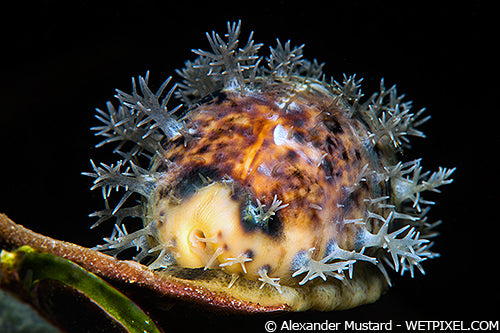
A powerful use of the LSD is not to create a spotlight within you frame, but create a spotlight large enough to illuminate your subject and foreground, but not the background. People won’t know it’s a “snoot shot”, but it gives you the ability to frame a benthic subject, like this cowrie in Raja Ampat, against a black background (of unlit reef). Nikon D4, Nikon 105mm VR. Subal housing. Single Seacam 150, Retra LSD Pro. 1/250th @ f/32. ISO 200.
For this type of image it is best to use the snoot on camera, centrally positioned above the port (for horizontal shots) and angled to light the subject and not the background. I usually take a minute or so to get the snoot approximately aimed at the beginning of the dive on a boring subject like a rock. Then I switch my focus to the AF-ON button (AKA back focus), so that the camera no longer focuses unless I tell it and I know that if the subject is in focus it is also in the light. Of course, the LSD snoots are designed to channel the aiming light of your strobe, which greatly helps when making small adjustments to strobe positioning. When making these small changes, I tend to adjust the snoot first, then hit AF-ON to refocus. However, I try and keep adjustments to a minimum. It is much better to look for several subjects of a similar size and orientation rather than constantly rejigging my system.
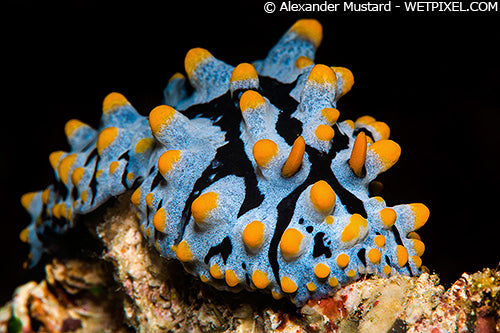
Close to the cowrie, above, I found this nudibranch on the seabed. I used the same setup, with just a minor tweak to strobe positioning, AF and ISO to quickly light the slug and not the surrounding seabed. Nikon D4, Nikon 105mm VR. Subal housing. Single Seacam 150, Retra LSD Pro. 1/250th @ f/32. ISO 100.
The LSD snoots produce strongly directional light, which is particularly suited for side lighting subjects and picking out texture. Using the strobe’s aiming light as guide it is quite easy to side light non-moving subjects and create simple, yet interesting images. Again I use a similar technique for these shots, of getting the lighting positioned correctly and the switching the AF activation to AF-ON only, so that when the camera is in focus, the lighting is correctly positioned. I’ll also hunt around for a range of subjects to shoot with this style of lighting before readjusting for another type of image.
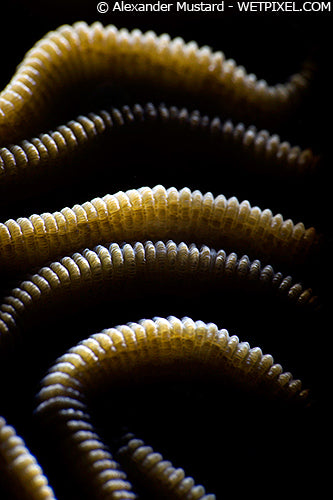
The ridges of a brain coral in the Cayman Islands picked out with narrow and strongly directional beam of the LSD. Nikon D4, Nikon 105mm VR and FIT prototype dioptre. Subal housing. Single INON Z240, Retra LSD Pro with PLE. 1/320th @ f/22. ISO 200.
Backlighting has always been an excellent way to create very different types of images of familiar subjects. This effect can be easily achieved with on-camera strobes, providing your strobe arms are long enough to reach round behind the subject. But it is often easier to set up with off-camera strobes. Of the two examples below, the rim-lighting on the fire coral was with an on camera strobe and the x-ray lighting on the waspish was with an off camera strobe.
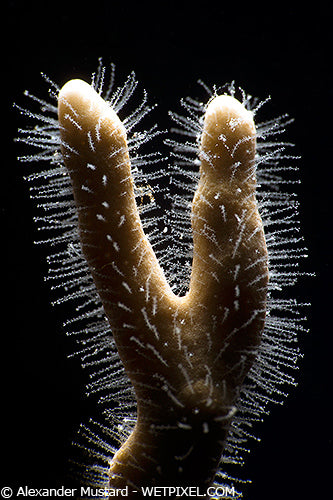
A rim-lit fire coral in Grand Cayman, shot with the LSD mounted on an on camera strobe, although with strobe arms long enough to reach around behind the subject. Nikon D4, Nikon 105mm VR and FIT prototype dioptre. Subal housing. Single INON Z240, Retra LSD Pro with circular insert with PLE. 1/320th @ f/22. ISO 200.
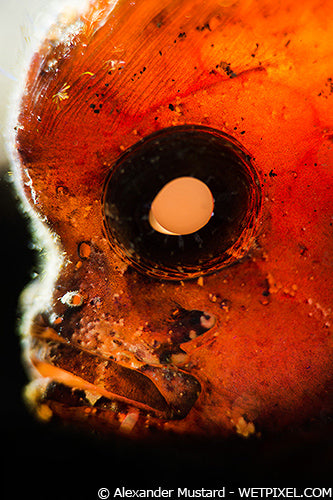
An x-rayed wasp fish in Lembeh. For this shot, the LSD Prime was mounted on an off-camera INON Z240, synched with a Triggerfish. Although it was not planned before the dive, my dive guide Joni spotted my gorilapod toppling over and held the strobe for me, aiming it at the other side of the translucent waspish. This is a great way to work. Nikon D4, Nikon 105mm VR and Subsee +5 dioptre. Subal housing. Single INON Z240, Retra LSD Prime with circular insert. 1/160th @ f/13. ISO 250.
Many photographers struggle with backlighting because they are fooled by the name, thinking “to back light a subject, the strobe must be completely behind it”. This is incorrect. To achieve backlighting the back of the subject must be lit, but the source of the light should be outside the frame (in other words, off to one side, not directly behind it). The LSD is highly suited to this as it creates a narrow beam of light, which can be precisely aimed at the subject, to create the backlighting effect, while minimizing backscatter and keeping the source of the light hidden. If the subject is large enough to completely hide the light source, we can place the strobe directly behind it.
It is also worth mentioning that another popular use of the LSD for competition photographers is to create in camera double exposures, placing a macro subject low in the frame and a wide angle background in the top of the frame, you can read more about this technique here on my website. As I am sure you will have realized, the LSD snoot is ideally suited to creating the foregrounds for double exposures, enabling you to generate a black background even in bright conditions.
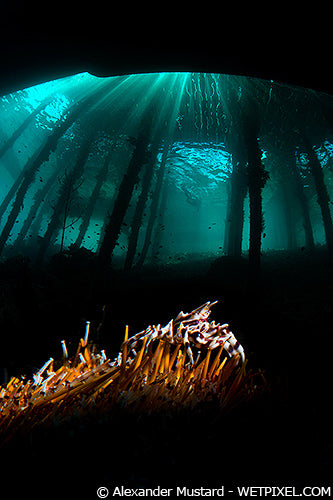
A trans-Indonesian double exposure of an urchin crab from Lembeh with a background of a silhouetted jetty from Raja Ampat. Macro part: Nikon D4, Nikon 105mm VR and Subsee +5 dioptre. Subal housing. Single INON Z240, Retra LSD Prime with circular insert. 1/160th @ f/36. ISO 250.
THOUGHTS ON STROBES
The LSD can be used either on a strobe mounted on-camera or off-camera. Both techniques are suited to certain types of lighting and subjects. For on-camera strobes, it is important to dive with long enough strobe arms to give you plenty of flexibility for aiming, but it is important not to waste your dive constantly moving the strobe. Find a position that works for a type of lighting and shoot a few different subjects before changing.
Off-camera use is in many ways simpler, certainly with a stationary subject on the sand, where there are plenty of places to position the strobe’s tripod. First aim the strobe and then you have flexibility to try several different camera angles, not worrying about the effect on the lighting.
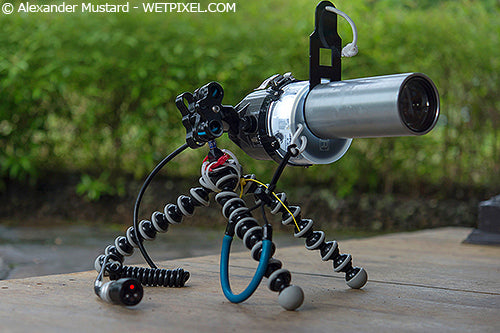
An off-camera setup with the LSD Prime at Tasik Ria in Manado. The LSD Prime is mounted on my INON Z240, with the square aperture inserted. The strobe is triggered by a cable and Triggerfish. There is also a lanyard attached for carrying underwater. This setup is slightly negatively buoyant, but with other strobes you may need to add a weight for stability.
The main equipment you need for off camera strobe work are a tripod (I use a plastic Gorillapod-SLR) with a mounting ball, so you can clamp the strobe to it. To trigger the strobe, you can often just get away with the strobes own optical sensor, for this type of shooting. However, here I am using a cable and Triggerfish slave sensor for more control.
Retra make both the Prime and Pro versions of the LSD for all the commonly used strobes. I am often asked if there is an ideal strobe for snoot photography. The bad news is no, the good news is that Retra’s LSDs are designed to work with all strobes. To explain, the best type of flash tubes for snoot photography are small ones, which create a concentrated source of light. However, to help aiming the LSD, it is easiest with a central strobe aiming light. And strobes with small flash tubes (INON Z240, S2000 and Sea & Sea D1) don’t have central focus lights. And strobes with central focus lights (Ikelite, Subtronic, Seacam) don’t have small flash tubes.
I took the LSD to Lembeh and ran into (what is the collective noun for photographers?) an album of photographers of NAD-Lembeh Resort from the Underwater Macro Photographers group. Looking around the resort it was quickly obvious that Japanese strobes dominate the market, with INONs and some Sea & Seas on all the rigs. Therefore it is important to many photographers that the LSD Prime works well on INON strobes. However, the ubiquitous INON Z240 is one of the more troublesome brands to deal with because the aiming light is considerably off-centre.
For the LSD Pro, Retra make an dog-legged EPL module that centers the INON aiming light on the intake for the LSD. On the cheaper LSD Prime, their solution is to move the intake away from the centre, so it still collects much of the power from the strobes, but also collects part of the Z240’s aiming light. This solution works, but it is not ideal because while the spotlight created by the aiming light gives a guide of where the snoot will light when the flash fires, it does not show the whole area. This is a frustration on your first dive with the unit, but is something you will quickly adapt to. Do note that this is only an issue on strobes without central aiming light.
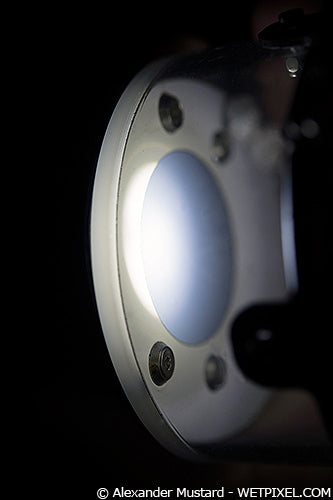
This photo shows the inside of the LSD Prime, when attached to an INON Z240. Note how the light from the strobe aiming light is not completely aligned with the intake for the LSD. This position of the LSD intake allows it to collect much more of the strobes flash power, but with the consequence that the aiming light coming through the LSD does not show the full area that will be illuminated. This issue only affects the use of the snoot with INON strobes.
CONCLUSION
Most people find their first few dives working with snoots very frustrating, so if you purchase one of Retra’s products, do give yourself 5 dives without before putting pressure on yourself to produce results.
Both the LSD Pro and Prime are very well made products and certainly demonstrate the advantages of an optical snoot. The new LSD Prime offers almost all of the performance of the LSD Pro at a much lower price point and comes with even more aperture masks for shaping the beam. The main advantages of the LSD over a simple funnel snoot are the greater working distance for small spots of lighting, the much greater efficiency allowing small apertures and therefore black background shots to be made in daylight and the ability to shape the beam. Furthermore with most strobes the LSDs can use the strobe’s aiming light to accurately show you what the strobe will illuminate before your shoot.
Although both units are expensive, I believe the price of each feels fully justified when you experience the quality and performance of the product. Furthermore, it is important to remember that the LSD can produce many types of lighting. Many photographers are focused on macro spotlights, but the snoot is well suited to creating directional side lighting and both rim and x-ray backlight. And, while I have not covered it in this review, the LSD is also well suited to backlighting and spotlighting in wide angle images. The LSD can be easily clipped on and off a strobe during a dive.
But personally I found it most exciting for simply being able to control what I lit and didn’t light within a scene. While I think that spotlighting subjects can feel overly contrived outside of competition shooting, I think that the ability to subtly light a subject and not the background is a very powerful benefit of the LSD for everyday photography. I was also drawn to the very directional quality of light and strong shadows that the collimated beam produced and this is something I look forward to experimenting more with in the future.
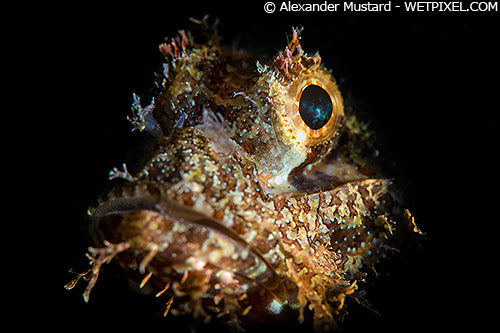
Face of a small scorpionfish on the reef, but photographed here with a back background by the careful aiming of the LSD. Nikon D4, Nikon 105mm VR, Subsee +5. Subal housing. Single INON Z240, Retra LSD Prime. 1/320th @ f/18. ISO 125.
In conclusion, a snoot is a valuable and versatile addition to any underwater photographers armory of techniques. And it is hard to think of a finer example on the market than Retra’s LSD Pro and LSD Prime.
Original article: http://wetpixel.com/articles/field-review-retra-lsd-prime-snoot

